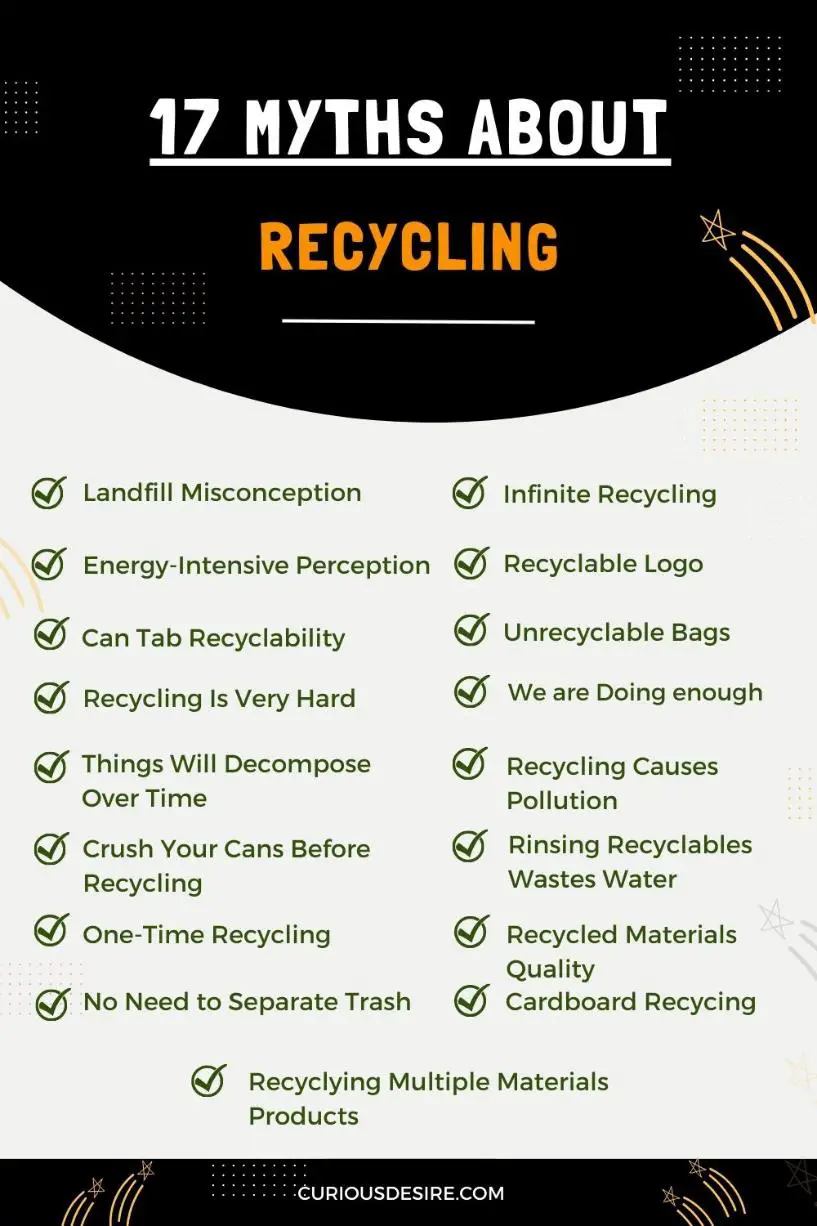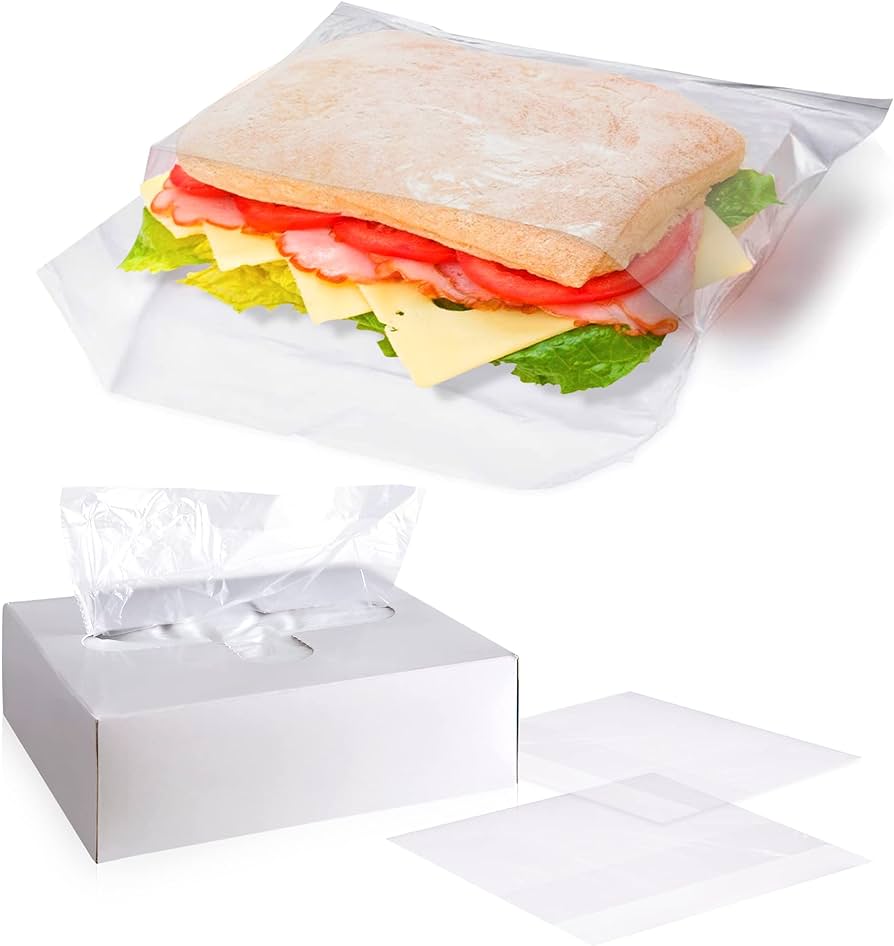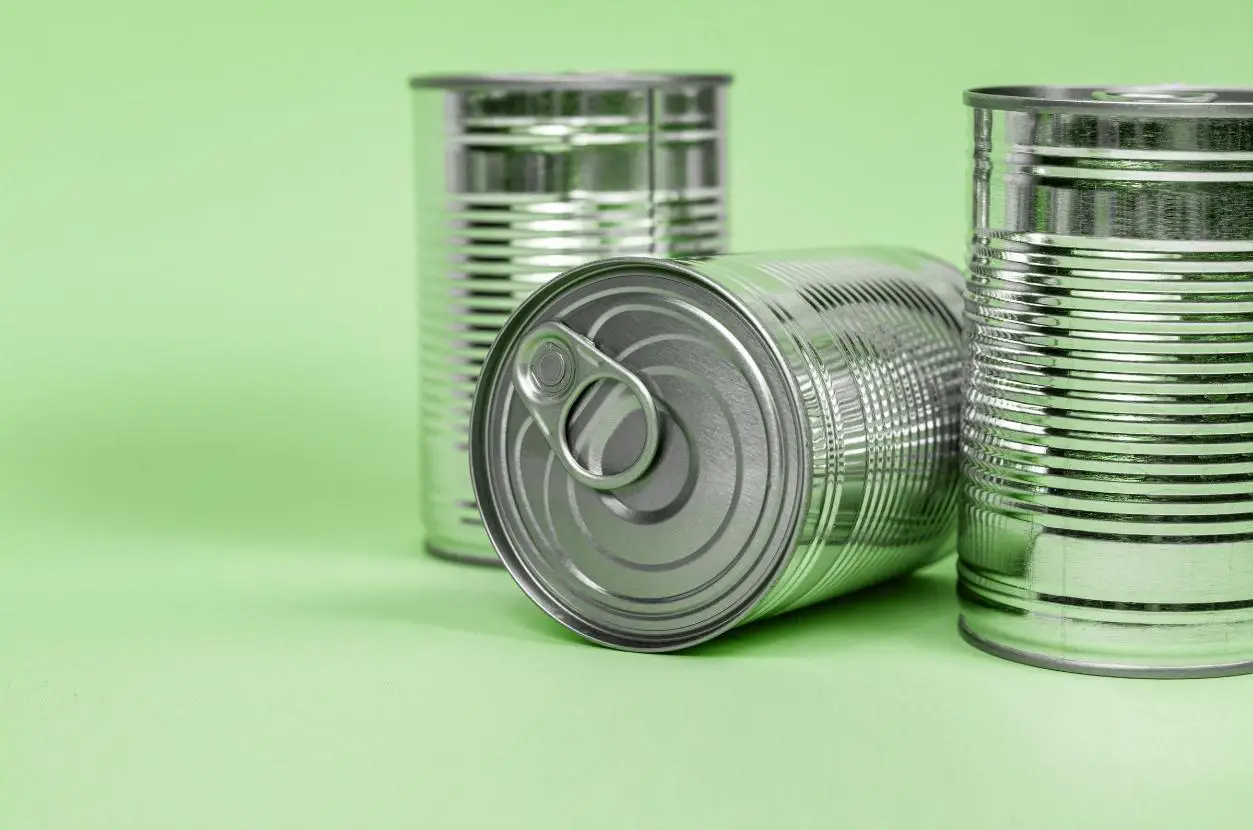Recycling is often seen as a crucial step towards being more environmentally friendly. However, in the midst of all the good intentions, some myths about recycling have managed to sneak into the conversation.
These misconceptions, whether they come from misunderstandings or just not having the right information, can affect how people view and participate in recycling efforts.
In this exploration, we’re going to look at common myths about recycling and dig into the truths behind each one.
[ez-toc]
17 Common Myths About Recycling
Let’s debunk the misconceptions surrounding recycling. Here are the prevalent myths about recycling that often lead people down the wrong path.
It’s time to set the record straight and gain a clearer understanding of how recycling truly works.

Myth1: Everything Ends Up In the Landfill, so Recycling Is a Scam
Some folks believe that all the effort we put into recycling is for nothing, thinking it’s a scam because everything ultimately ends up in the landfill.
However, this is far from the truth. Recycling plays a crucial role in diverting a significant amount of waste away from landfills, lessening the environmental burden.
Materials such as paper, glass, and specific plastics are given a second chance at life through the recycling process.
By sorting and recycling our waste, we actively contribute to the reduction of landfill waste, supporting a more sustainable and eco-friendly approach to waste management.
Myth 2: Recycled Materials Are Possible to Recycle Forever
While the idea of endlessly recycling materials seems appealing, it’s essential to recognize the limits. Recycled materials can indeed go through multiple cycles, but each round may result in a slight decrease in quality.
This doesn’t diminish the significance of recycling; on the contrary, it underscores the importance of continually finding innovative ways to recycle and encouraging responsible consumption.
Despite the limitations, recycling remains a powerful tool for conserving valuable resources and reducing the environmental impact associated with the extraction and production of raw materials.
Myth 3: Recycling Is Energy-Intensive and Not Sustainable
It’s commonly thought that recycling is energy-intensive and not sustainable due to the perception that the recycling process requires significant energy inputs, making it less environmentally friendly than simply discarding items or using new materials.
But in reality, recycling typically requires less energy compared to extracting raw materials and manufacturing new products. By reusing materials, we reduce the demand for energy-intensive processes, resulting in lower carbon emissions.
Here are the key points to grasp the concepts:
- Energy Efficiency: Recycling uses far less energy than extracting raw materials. For example, recycled aluminum requires about 95% less energy than new production.
- Resource Conservation: By reusing materials, recycling significantly reduces the need for extensive mining or logging, preserving natural habitats.
- Lower Carbon Footprint: Recycling leads to fewer carbon emissions compared to manufacturing from raw materials, reducing energy used in extraction and transportation.
- Circular Economy Impact: Recycling keeps materials in use, lessening landfill waste, minimizing pollution, and preserving finite resources.
- Technological Advancements: Ongoing improvements in recycling tech make processes more efficient, reducing energy use and enhancing sustainability.
Myth 4: The Recyclable Logo Guarantees Recyclability
The familiar recyclable logo is not a universal guarantee of recyclability. It serves as an identifier for the type of material, but whether an item can be recycled depends on local recycling facilities.
Different regions have varying capabilities and requirements for processing materials. Therefore, it’s crucial for individuals to understand and follow local recycling guidelines to ensure the effective recycling of items marked with the recyclable logo.
Myth 5: The Tab Is the Only Recyclable Part of a Can
There’s a common misconception that only the tab of a beverage can is recyclable. In reality, the entire can, including the tab, is typically made from the same material and can be recycled together.
This misconception might stem from the historical use of different materials for tabs, but modern cans are designed for full recyclability.
Properly disposing of the whole can ensure that both parts can be processed together in the recycling system.
Myth 6: Sandwich Bags Can’t Be Recycled
The recyclability of sandwich bags depends on the type of material they are made from. Some recycling programs accept certain types of plastic bags, including those used for sandwiches.
It’s essential to check local recycling guidelines to determine whether sandwich bags can be included in the recycling bin.

Myth 7: Recycling Is Very Hard
Some folks may feel overwhelmed by the idea of recycling, thinking it’s a complicated task. The truth is, that recycling is more straightforward than it appears.
Most recycling programs provide clear guidelines on what can be recycled and how to sort items properly. Sorting materials like paper, plastics, glass, and metals becomes manageable.
Every small effort diverts waste from landfills, reduces pollution, and fosters a sustainable culture with lasting environmental benefits.
Myth 8: We Are Recycling as Much as We Can
There’s a prevalent misconception that current recycling efforts are at their maximum potential, assuming that society is already recycling as much as feasibly possible.
The reality is that there’s substantial room for improvement and expansion in recycling practices. Many regions and industries can enhance collection, sorting, and processing methods.
Raising awareness and adopting advanced technologies offer opportunities for increased recycling rates, indicating that current efforts aren’t yet maximal.
Myth 9: Things Will Decompose Over Time
Many believe that all materials will naturally decompose over time. However, this isn’t the case, especially with synthetic materials like plastics that linger for extended periods without breaking down.
Certain things, especially those made of synthetic materials like plastics, don’t easily break down naturally. They can stick around for a long time, causing environmental issues.
Recycling becomes crucial in managing these materials responsibly and minimizing their impact on the environment. It’s essential to understand that not all items biodegrade and we need to adopt practices like recycling to mitigate the lasting effects on our planet.

Myth 10: Recycling Causes More Pollution Than It Prevents
Contrary to the belief that recycling contributes to pollution, it is, in fact, a powerful ally in the fight against environmental harm.
When we recycle, we reduce the demand for new raw materials, slashing the pollution generated by traditional manufacturing processes.
By using recycled materials, we lessen the need for extracting resources and decrease energy consumption.
Myth 11: Crush Your Cans Before Recycling Them
The myth that crushing cans is a necessary step in recycling has circulated, but the reality tells a different story. While it might seem like a space-saving superhero move, crushing cans is not essential for the recycling process.
In fact, it can complicate things. When cans are crushed, it makes sorting at recycling facilities more challenging, potentially leading to less efficient recycling.
So, rather than transforming cans into flat material, it’s better to let them maintain their original form, ensuring a smoother recycling journey.
Myth 12: Rinsing Recyclables Wastes Too Much Water
The notion that rinsing recyclables is a water-wasting act is a common misconception. In reality, a quick rinse plays a crucial role in maintaining the quality of recyclable materials.
The small amount of water used during rinsing is minimal compared to the environmental benefits gained by preventing contamination.
This simple act ensures that materials are clean and ready to be transformed into new products, underscoring the importance of balance in our efforts to be environmentally conscious.
Myth 14: Materials Can Only Be Recycled Once
The idea that materials can only be recycled a single time is a recycling myth debunked by the resilience of materials like glass and aluminum.
These recyclable superheroes can undergo the recycling process repeatedly without sacrificing their quality.
Myth 14: Recycled Materials Are of Poor Quality
Dismissing recycled materials as inferior is far from the truth. In reality, recycled materials can meet the same quality standards as those produced from raw materials.
Technological advancements in recycling processes ensure that the recycled counterparts are just as durable and reliable.
This dispels the myth that recycled products compromise on quality, emphasizing the role of recycling in creating products that are both environmentally friendly and of high caliber.
Myth 15: No Need to Separate Trash from Recycling
Myth 16: Cardboard Is Always Recyclable
While cardboard is commonly regarded as a recycling hero, it’s essential to note that not all cardboard is universally recyclable.
Certain types may come with coatings or contamination that can impact their recyclability. By adhering to local guidelines, we ensure that our cardboard receives the right treatment, guiding them on a journey toward transformation into new and sustainable products.
Myth 17: You Can’t Recycle Products Made From Multiple Materials
Some believe that items with different materials are too complex for recycling, but the recycling world has solutions. Advanced processes can handle mixed-material items, showing the flexibility of recycling.
The key is designing products with recycling in mind, making it easier for these materials to find a second life.
Understanding the recyclability of various materials is essential to keeping the recycling process effective and contributing to a more sustainable environment.
Recycling Myths FAQs
1. What are some true facts about recycling?
Recycling is a process that transforms waste materials into new products to reduce the consumption of raw materials and energy.
True facts about recycling include its positive environmental impact, as it conserves resources, reduces pollution, and lowers greenhouse gas emissions.
Additionally, recycling helps in waste management by diverting materials from landfills, extending the lifespan of these disposal sites.
2. What are some amazing facts about recycling?
Some amazing facts about recycling include that recycling one ton of paper can save 17 trees, and recycling aluminum cans saves 95% of the energy required to make the same amount of aluminum from raw materials.
Furthermore, the energy saved from recycling one glass bottle can power a light bulb for four hours. These facts highlight the significant benefits of recycling in terms of resource conservation and energy efficiency.
3. What are the most common recycling mistakes?
Common recycling mistakes include contamination of recyclables with non-recyclable materials, such as food residues or plastic bags.
Another mistake is not following local recycling guidelines, as different municipalities may have specific requirements.
Putting items with mixed materials, like pizza boxes with grease stains, into recycling bins is also a prevalent error that can hinder the recycling process.
4. What is the hardest waste to recycle?
Electronic waste, or e-waste, is often considered the hardest waste to recycle. This category includes discarded electronic devices like computers and smartphones, which contain complex components and hazardous materials.
Proper disposal and recycling of e-waste require specialized processes to extract valuable materials while minimizing environmental impact.
5. What is the hardest product to recycle?
Among products, mattresses are often considered challenging to recycle. Their size, composition, and mix of materials make the recycling process complex.
However, efforts are being made to develop innovative methods to recycle mattresses and reduce the environmental impact of their disposal.
6. Which products cannot be recycled?
Products that cannot be recycled often include certain types of plastic bags, Styrofoam, and certain types of glass, such as mirrors and window panes.
Additionally, items contaminated with hazardous materials, like paint cans with residual paint, are typically not accepted in recycling programs.
7. What is the most expensive thing to recycle?
Nuclear waste is one of the most expensive materials to recycle. The process involves sophisticated technology and stringent safety measures due to the potential hazards associated with radioactive materials.
8. What is the #1 item that can be recycled?
Aluminum cans are often considered the number one item that can be recycled. They are highly valuable in the recycling process because recycling aluminum requires significantly less energy compared to extracting it from raw materials.
9. What materials can be 100% recycled?
Materials like glass, aluminum, and certain types of paper can be 100% recycled without a loss of quality. This means that these materials can be reused repeatedly without compromising their integrity.
10. Can glass be recycled?
Yes, glass is recyclable. It is a highly sustainable material that can be recycled indefinitely without losing its quality.
Recycling glass helps reduce the demand for new raw materials and lowers energy consumption in the manufacturing process.
11. What is the most recycled plastic?
Polyethylene terephthalate (PET) is one of the most commonly recycled plastics. It is widely used in the production of beverage bottles and food containers. The recycling of PET helps conserve resources and reduce environmental impact.
12. Is plastic 100% recycled?
While some plastics can be recycled, achieving 100% recycling for all types of plastic is challenging. Certain plastics may degrade in quality during the recycling process, limiting their ability to be recycled endlessly.
13. Can you recycle PET 1?
Yes, PET 1, which stands for polyethylene terephthalate, is a type of plastic that is commonly recycled. It is widely accepted in recycling programs and can be turned into various products, including new bottles and containers.
14. Which country recycles the most plastic?
As of my last knowledge update in January 2022, Germany was among the leading countries in plastic recycling, with high rates of collection and recycling infrastructure.
However, these rankings may have changed, and it’s essential to refer to the latest data for the most accurate information.
15. Which item do people most often mistake as not recyclable?
People often mistake plastic bags for non-recyclable items. While many recycling programs do not accept plastic bags in curbside bins due to the risk of tangling in machinery, some grocery stores and retailers have collection bins specifically for plastic bag recycling.
16. What are the 7 disadvantages of recycling?
While recycling offers numerous benefits, there are some disadvantages, including high initial costs of recycling infrastructure, energy consumption during the recycling process, potential pollution from recycling operations, and the challenge of recycling certain materials effectively.
Additionally, the transportation of recyclables can contribute to carbon emissions.
17. What is the main problem with not recycling?
The main problem with not recycling is the excessive strain on natural resources. Failing to recycle results in increased extraction of raw materials, higher energy consumption in manufacturing, and the rapid depletion of finite resources.
Additionally, the improper disposal of non-recyclable items contributes to pollution and environmental degradation.
18. What is the most difficult material to recycle, and why?
One of the most difficult materials to recycle is composite materials, which consist of multiple layers of different materials bonded together.
These materials, often used in packaging or products for their specific properties, pose challenges in separation and processing, making recycling a complex and expensive process.
Examples include Tetra Paks, which are commonly used for beverage packaging.

